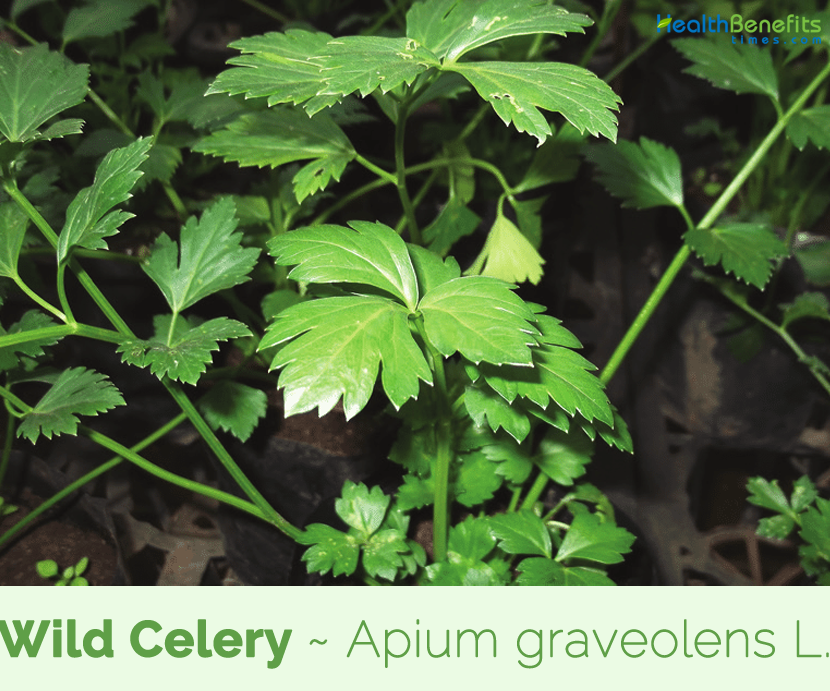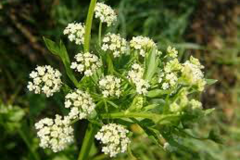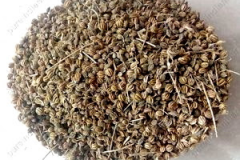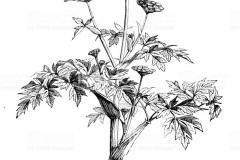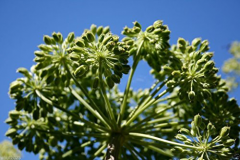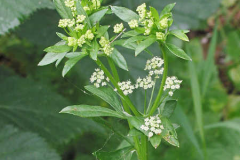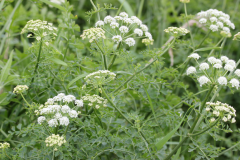| Wild Celery Quick Facts |
| Name: |
Wild Celery |
| Scientific Name: |
Apium graveolens L. |
| Origin |
Marshy areas throughout temperate Europe and Western Asia |
| Colors |
Grayish brown to brown |
| Shapes |
Schizocarp with two mericarps, sub-orbicular to ellipsoid, 1–2 mm in diameter |
| Taste |
Bitter, sweet, astringent |
| Health benefits |
Beneficial for high blood pressure, rheumatism and kidney complaints, relieves indigestion, stimulates uterus, hysteria, bronchitis, asthma, liver, and spleen diseases. |
Wild Celery scientifically known as Apium graveolens L. is an herbaceous annual or biennial plant belonging to Apiaceae ⁄ Umbelliferae (Carrot family) and Plantae kingdom along with carrots, caraway, cumin, fennel and dill (each of which also grows wild). The plant is native to marshy areas throughout temperate Europe and Western Asia. Although the eastern Mediterranean region appears to be the most logical center of domestication, the distribution of wild types raises some doubt. Few of the popular common names of the plant are Angelica, garden angelica, wild celery, Norwegian angelica, Herb of the Holy Spirit, Holy Ghost, Marsh parsley and Smallage.
Wild celery is readily distinguished from domesticated celery by its thin whispy stems and long, toothed, lush leafy foliage. Its coloring is true green through, its aromatics herbaceous and an indicator of its flavor, layered with notes of chevril, fresh coriander, fennel and mint. Wild celery is classified within the culinary landscape as a cool tasting ingredient due to its high levels of the anise-flavored volatile compound, anethole. Other herbs and vegetables that carry the same cool tasting label include basil, clove, tarragon, mint and root vegetables.
Plant description
Wild celery is an herbaceous annual or biennial erect flowering herb that grows about 0.6 m (2 ft) tall and 0.3 m (1 ft) wide. The plant can be found growing in humid, deciduous woodlands, partially shaded area of the yard, along hedgerows, beneath orchard trees, shady banks, under bracken on coastal cliffs, uplands, meadows, under bracken in upland areas and garden escape. The plant has shallow root that is thickened in the middle. Stem is branched, furrowed, succulent, and rigid. Leaves are radical, pinnate, deeply divided into three segments, once or twice divided and toothed at apex. The leaflets are ovate to sub-orbicular, 3-lobed, 2–4.5 cm long.
Flowers are small, white in color and inflorescence is a compound umbel. Calyx teeth are obsolete; five petioles ovate, acute with tip inflexed; carpels semi-terete, sub-pentagonal, primary ridges distinct and fili-form. Flowering normally takes place from January to August. Fertile flowers are replaced by schizo carp with two mericarps, sub-orbicular to ellipsoid, 1–2 mm in diameter, aromatic and slightly bitter. They are grayish brown to brown colored.
History
Traditionally it was used in Indian medicine to treat flatulence, asthma and hiccups, and remains of it were found in Tutankhamen’s tomb—as was chervil. It is one of the oldest vegetables in recorded history. Ancient Egyptians were known to gather wild celery from marshy seaside areas for food, and Greeks crowned their athletes with celery leaves to honor them.
Traditional uses and benefits of wild Celery
- Wild celery has a long history of medicinal and food use.
- It is an aromatic bitter tonic herb that reduces blood pressure, relieves indigestion, stimulates the uterus and is anti-inflammatory.
- Ripe seeds, herb and root are aperient, carminative, diuretic, emenagogue, galactogogue, nervine, stimulant and tonic.
- Wild celery is said to be useful in cases of hysteria, promoting restfulness and sleep and diffusing through the system a mild sustaining influence.
- The root is harvested in the autumn and can be used fresh or dried.
- Whole plant is harvested when fruiting and is usually liquidized to extract the juice.
- An essential oil obtained from the plant has a calming effect on the central nervous system.
- Some of its constituents have antispasmodic, sedative and anti-convulsant actions.
- It has been shown to be of value in treating high blood pressure.
- Homeopathic remedy is made from the herb.
- It is used in treating rheumatism and kidney complaints.
- Wild celery is an aromatic bitter tonic herb that reduces blood pressure, relieves indigestion, stimulates the uterus and is anti-inflammatory.
- Wild celery is said to be useful in cases of hysteria, promoting restfulness and sleep and diffusing through the system a mild sustaining influence.
- Celery seeds are used in India to treat bronchitis, asthma, liver, and spleen diseases.
- It is drunk as tea to reduce blood pressure and lower cholesterol levels as it contains chemical compounds called coumarins that thin the blood.
- Celery seed also helps rid the body of uric acid that often causes pain and inflammation in gout and arthritis.
- The plant compound luteolin reduces inflammation in the brain, and benefits cognitive health.
Ayurvedic health benefits of Wild celery
- Detoxificant: Boil One teaspoon of Wild Celery Seeds in one cup of water for 15 minutes. Drink every day.
- Relaxant: Mix One teaspoon of Wild Celery powder in a little water or tea. Take twice a day.
- Aphrodisiac: Wild Celery roots strengthen the sex organs in both men and women. Add Wild Celery roots in your soups. You can also eat fresh root as a salad.
- Kidney stones: Boil Wild Celery stems and leaves in water. Drink 1 glass of it daily.
- Gout: Make a tea by adding 2 tablespoons of Wild Celery seeds in 8 cups of water. Pour it in a covered pot and simmer slowly for 3 hours. Filter and drink hot One cup thrice a day
- For Skin: Add Wild Celery in your daily diet as a salad to get rid of Skin Problems. OR: Drink Wild Celery tea once a day.
- Aging: Take Wild Celery juice regularly. It regulates the water balance and puts new energy into elderly people.
- Rheumatism: Take One tablespoon juice thrice a day, an hour before every meal.
- Stomach Ache: Take crushed leaves. Mix rock salt in it. Take one tablespoon after meals.
- Neuralgia: Prepare infusion of Wild Celery. Take half cup twice a day.
- Ulcer: Boil the herb in a cup of water for 2-3 minutes. Drink it as a tea.
- Aphonia: Make decoction of the leaves of Wild Celery. Gargle with it.
- Obesity: Extract juice of Wild Celery plant. Take 1 tsp thrice a day. OR: Take raw Wild Celery as salad. It gives the feeling of fullness and also reduces belly fat.
- Menstrual disorders: Chew fresh leaves and stem of Wild Celery during Menstrual Delay.
- High blood pressure: Wild Celery contains compound called Phthalides. It eases the muscle tissues and enhances the flow of blood. This reduces the blood pressure. Eat one or two stalk of Wild Celery along with a glass of water.
- Joint pain: Boil 1 teaspoon Wild Celery Seeds in a cup of water for 10 minutes. Strain it off. Drink this mixture thrice a day to reduce the stiffness of joints. OR: Consume a half teaspoon dry powder of Wild Celery Seeds with a glass of tepid water daily to alleviate the pain of joints.
- Bell’s palsy: Chew raw Wild Celery leaves and stems daily.
- Rheumatoid Arthritis: Take Combined mixture of Black Cohosh, Bogbean, White Poplar and Wild Celery to treat Rheumatoid Arthritis. It can be taken internally as an Infusion. Prepare an Infusion of the dried leaves. Let leaves steep for l0 – l5 minutes. Drink before taking meals. Take thrice a day
- Arthritis: Prepare a decoction of Devil’s Claw, Wild Celery Seed and Bogbean leaves. Drink twice a day.
- Athlete’s Foot: Prepare a paste of raw Tomatoes, Basil leaves, Wild Celery, Carrot, Dill, Fennel, Sage and Thyme. Apply this paste on the affected area.
- Flatulence: Fry one gram Asafoetida in purified butter. Add 3 tsp Wild Celery seeds and half tsp Black Salt in it. Take 3 g with lukewarm water twice a day.
- Flatulence: Make a mixture of one teaspoon of roasted Cumin seeds powder, one teaspoon of Wild Celery seeds, one teaspoon of dried Ginger powder and ¼ teaspoon of Black Salt. Take ½ teaspoon of the mixture with lukewarm water, twice a day.
- Premenstrual Syndrome: Take half teaspoon of Wild Celery seeds, half teaspoon of Dried Ginger powder. Fry them in one teaspoon of Ghee. Add one teaspoon Jaggery (crushed). Heat it for half minute. Have it with one cup milk once before a week of menstrual cycle.
- Anemia: Prepare juice of Wild Celery leaves and Carrot. Strain. Drink.
- Bloating: Take 1/4 teaspoon of each Aniseed and Wild Celery. Boil in one glass of water. Consume it twice a day.
- Anorexia: Take equal quantity of dried Ginger root, Long Pepper, Wild Celery seeds, Cumin and salt. Grind them to make powder. Store. Take half tsp with your meal. Have it two times a day.
- Constipation: Take Wild Celery seeds, Cumin and Asafoetida in equal quantity. Grind them to make powder. Take quarter tsp of it 10 mins. Before your meal.
- Irritable Bowel Syndrome: Mix Nutmeg powder, Indian Gooseberry powder and Wild Celery seeds in 1:2:2 ratios. Take 4 gram of it during bedtime with warm Milk.
- Gout: Take juice of Cucumber, Carrot, Wild Celery and Beetroot in equal quantity. Mix. Drink 100 ml of it thrice a day.
- Eye Disease: The fusion of Chicory, Wild Celery, Parsley and Carrot is an ideal remedy for healthy Eyes. OR Take 20 ml Chicory juice, 50 ml Wild Celery juice, 40 ml Parsley juice and 70 to 80 ml Carrot juice. Mix all the juices and drink it 2 times a day.
- Anemia: Mix 15 g of Chicory roots with similar amount of Wild Celery and Parsley. Add this to your daily diet. Eat this combination twice a day.
- Water Retention: Put 1 to 2 leaves of Blackberry, 1 bunch of Parsley, ½ teaspoon of Wild Celery, 1 to 2 chopped leaves of Dandelion, 10 stems of Cherry, ½ to 1 teaspoon of Corn Silk, ½to 1 teaspoon of Fennel Seed, ½ to 1 teaspoon of Cynodon Dactylon in a pot containing 1 liter of boiling water. Simmer it for 15 to 20 minutes. Strain this decoction. Drink this tea thrice a day.
Culinary Uses
- Leaves can be consumed raw or cooked.
- Leaves are mainly used as a flavoring in soups etc.
- They can be eaten raw but have a very strong flavor.
- Seed is used as a flavoring.
- It can also be used in small quantities to flavor soups and stews.
- An essential oil from the seed is also used as s flavoring.
- In France, itis often used in soups and stews, as the French feel it gives more concentrated flavor than domesticated celery.
Precaution
- If the plant is infected with the fungus Sclerotinia sclerotiorum, skin contact with the sap can cause dermatitis in sensitive people.
- Allergic responses include anaphylaxis in sensitive individuals.
- Avoid during pregnancy as emenagogue, abortifacient and uterine stimulant activity reported.
- Avoid if you have a kidney disorders.
- Allergic reactions may include hives, swelling, breathing troubles and potentially fatal shock.
- You may get a skin reaction after handling the plant and then being exposed to sunlight.
- Seed oil in large amount might causes central nervous system problems.
- Heavy dosage may cause diarrhea and upset stomach.
- Topical exposure to celery may cause contact dermatitis, angio edema and urticaria.
Attractive to Bees
Apium graveolens is a member of the Apiaceae (parsley) family and a relative of dill and carrots. The genus name is derived from the Latin, apis (bee), as bees are attracted to its small white flowers. The species name graveolens means “heavy scented.” Our English word celery is possibly from the Latin celer, meaing swift, as celery is considered a fast-acting remedy.
References:
http://www.floracatalana.net/apium-graveolens-l-
https://botanical.com/botanical/mgmh/c/celery45.html
https://www.itis.gov/servlet/SingleRpt/SingleRpt?search_topic=TSN&search_value=29592#null
https://davesgarden.com/guides/pf/go/89489/
https://npgsweb.ars-grin.gov/gringlobal/taxonomydetail.aspx?id=300034
https://pfaf.org/user/plant.aspx?LatinName=Apium+graveolens
https://plants.usda.gov/core/profile?symbol=APGR2
http://www.theplantlist.org/tpl1.1/record/kew-2644053
https://www.researchgate.net/publication/260211038_Monograph_of_Apium_graveolens_Linn
References:
Comments
comments
